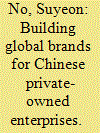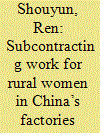|
|
|
Sort Order |
|
|
|
Items / Page
|
|
|
|
|
|
|
| Srl | Item |
| 1 |
ID:
161566


|
|
|
|
|
| Summary/Abstract |
While most private-owned enterprises (POEs) in China are engaged in subcontracting or do not own the product brands, the number of POEs with their own brands has increased rapidly, while some are even globally recognized. Since these POEs face high opportunity costs for own branding, given their dominant presence in the global subcontracting community, their own branding actions require contextual understanding of doing business in China. This study starts with the notion of how these POEs shift from subcontracting to own branding, and explores their respective own branding paths. We interviewed seven Chinese POEs in the fashion industry in Zhejiang Province: Babei, Baili, Sunrise, Aokang, Youngor, Kangnai, and JNBY. The case studies suggest how these firms built their brands in the global market, and why their trajectories differentiated in the course of own branding. Our study configures three types of own brand models for POEs: the competitive subcontracting, the toehold, and the home-linked organic models. POEs can continue subcontracting in their core business, while implementing own branding through diversification. Alternatively, they can segregate markets, pursuing own branding in one group of countries, while subcontracting elsewhere. In addition, they may establish wholly owned enterprises, and introduce their brands in a way that preserves their home market advantages. We identify two stimuli for Chinese POEs’ global branding choices. Global branding strengthens domestic position as it becomes a signal for reputation. As the online platform reduces costs for global branding, and becomes popular, POEs are more likely to pursue global branding to become more competitive in the domestic market. Many POEs also continue to collaborate with the previous customers through strategic inter-dependence, such as distribution channel exchange.
|
|
|
|
|
|
|
|
|
|
|
|
|
|
|
|
| 2 |
ID:
153639


|
|
|
|
|
| Summary/Abstract |
Industrial subcontracting work in rural China has been framed as a win-win strategy for women and industry. Drawing on fieldwork conducted in Hebei Province, I argue that far from being the main beneficiaries of subcontracting work, such rural industrialization has instead subjected women to a gendered form of capitalist exploitation. First, the women employed were not a random group but were young, healthy women who already had industrial skills, and thus did not need training. Second, these women were rendered immobile by their family responsibilities. Third, the problems of ‘left-behind’ children and an urban, modern notion of motherhood trickling down to the countryside has constructed a notion of virtuous motherhood. Further undermining their position, women workers had no influence over production or profits in the subcontracting chain. Despite the promise that subcontracting work would be flexible for women, such flexibility benefits the production chain more than women workers. Local (and changing) gender and development dynamics in rural China condition the experiences of women involved in initiatives that are seen as a win-win situation by some development agencies, advocacy groups and policy researchers.
|
|
|
|
|
|
|
|
|
|
|
|
|
|
|
|
|
|
|
|
|